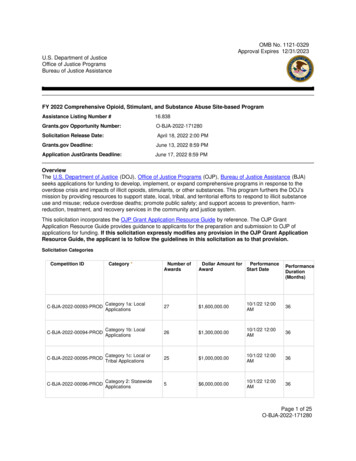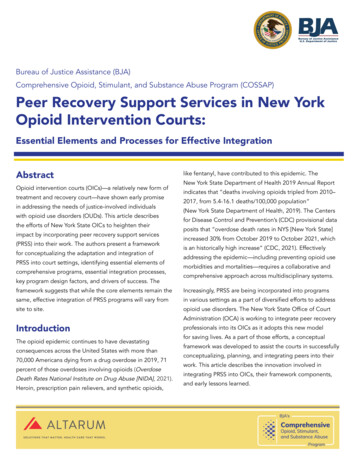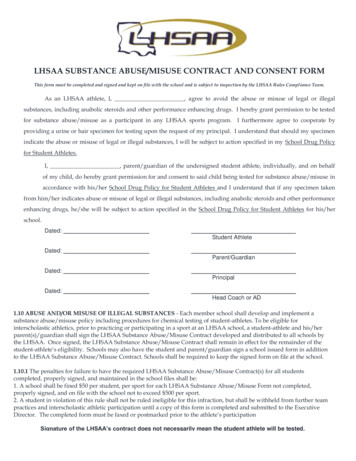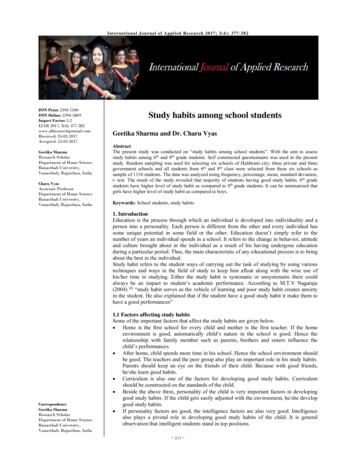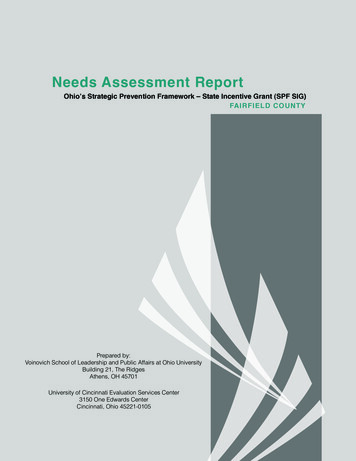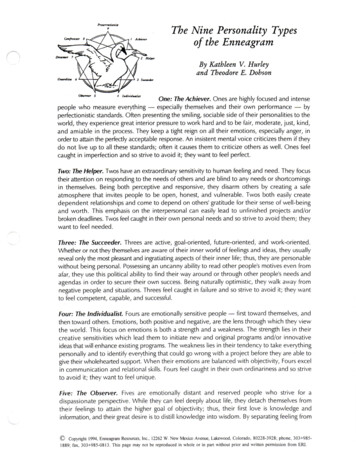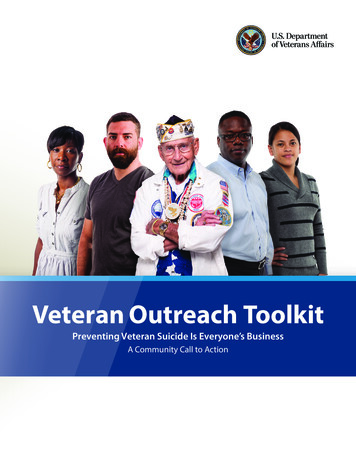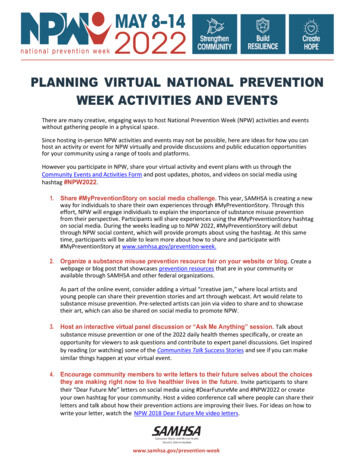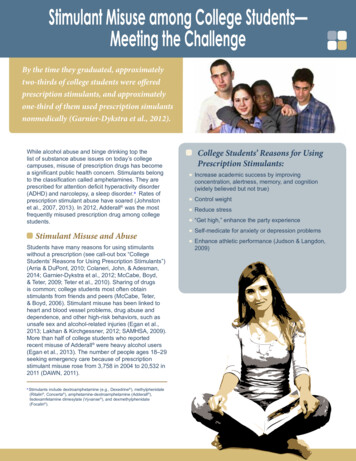
Transcription
Stimulant Misuse among College Students—Meeting the ChallengeBy the time they graduated, approximatelytwo-thirds of college students were offeredprescription stimulants, and approximatelyone-third of them used prescription simulantsnonmedically (Garnier-Dykstra et al., 2012).While alcohol abuse and binge drinking top thelist of substance abuse issues on today’s collegecampuses, misuse of prescription drugs has becomea significant public health concern. Stimulants belongto the classification called amphetamines. They areprescribed for attention deficit hyperactivity disorder(ADHD) and narcolepsy, a sleep disorder.a Rates ofprescription stimulant abuse have soared (Johnstonet al., 2007, 2013). In 2012, Adderall was the mostfrequently misused prescription drug among collegestudents.Stimulant Misuse and AbuseStudents have many reasons for using stimulantswithout a prescription (see call-out box “CollegeStudents’ Reasons for Using Prescription Stimulants”)(Arria & DuPont, 2010; Colaneri, John, & Adesman,2014; Garnier-Dykstra et al., 2012; McCabe, Boyd,& Teter, 2009; Teter et al., 2010). Sharing of drugsis common; college students most often obtainstimulants from friends and peers (McCabe, Teter,& Boyd, 2006). Stimulant misuse has been linked toheart and blood vessel problems, drug abuse anddependence, and other high-risk behaviors, such asunsafe sex and alcohol-related injuries (Egan et al.,2013; Lakhan & Kirchgessner, 2012; SAMHSA, 2009).More than half of college students who reportedrecent misuse of Adderall were heavy alcohol users(Egan et al., 2013). The number of people ages 18–29seeking emergency care because of prescriptionstimulant misuse rose from 3,758 in 2004 to 20,532 in2011 (DAWN, 2011).aStimulants include dextroamphetamine (e.g., Dexedrine ), methylphenidate(Ritalin , Concerta ), amphetamine-dextroamphetamine (Adderall ),lisdexamfetamine dimesylate (Vyvanse ), and dexmethylphenidate(Focalin ).College Students’ Reasons for UsingPrescription Stimulants:academic success by improving Increaseconcentration, alertness, memory, and cognition(widely believed but not true) Control weight Reduce stress “Get high,” enhance the party experience Self-medicate for anxiety or depression problemsathletic performance (Judson & Langdon, Enhance2009)
Addressing the Problemscreening for alcohol and drugs. Brief questionnaires(see the “Screening for Prescription Drug Use Problems”Issue Brief) are useful for identifying students at riskfor abuse or dependence and can serve as a startingpoint for further assessment or referral to treatment.The University of California, Los Angeles, Access toCare program, for instance, uses the Alcohol, Smokingand Substance Involvement Screening Test (ASSIST)to assess the severity of substance use and identifyappropriate treatment (WHO ASSIST Working Group,2002).Responding to the huge increase in stimulant abuse,many colleges are changing their procedures on howtheir student health offices handle ADHD, includingthe diagnosis of ADHD and filling prescriptions ofamphetamine-based medications like Vyvanse andAdderall (Colaneri, John, & Adesman, 2014; Schwarz,2013; Vimont, 2014). Students, parents, health careproviders, college advisors and counselors, and collegeadministrators all can play a role in discouraging misuseof prescription drugs. Strategies to reduce stimulant drugmisuse among college students include the following:Education and Training Assessing the prevalence of stimulant abuse Offering education and trainingdiversion prevention and enforcement, Employingincluding always checking the state’s PrescriptionDespite common beliefs, the use of stimulants bystudents who do not have ADHD does not improveschool performance (Advokat & Scheithauer, 2013).Parents, community organizations, federal and stategovernments, and colleges and universities can helpdispel the myth that stimulants help students succeed.In addition, colleges and universities can informstudents about the school’s substance use policies andenforcement procedures, the signs and symptoms ofstimulant abuse, the importance of taking medicationsonly as prescribed, and where to go for help forthemselves or others. Vanderbilt University, for example,includes prevention messages regarding stimulantmisuse in its new student orientation (DAWN, 2011).Monitoring Program database before writing,renewing, or dispensing any prescription foramphetamines or other Schedule II drugs Providing access to diagnostic and treatment servicesFaculty, staff, faculty advisors, health services staff,coaches, residence hall advisors, and others all needto know about the warning signs and symptomsof prescription drug abuse and misuse and howto respond. Training for health services staff whoprescribe stimulants or assist in patient care includes(1) reminders to be aware of the high prevalence ofdrug diversion; (2) giving patients explicit instructionsregarding the ways in which these medications should—and should not—be used; (3) providing clear warnings tostudents against sharing and selling medications (e.g.,this is drug dealing and grounds for both expulsion andprosecution); and (4) including specific instructions onhow to dispose of unused medication (Arria, 2010).Problem AssessmentAn important first step is to determine the prevalenceof prescription drug diversion on campus (Garnieret al., 2010; CARS, 2014). Campus-wide surveyscollect information regarding the reasons for misuse,misconceptions about health effects, and social normsaround prescription drug use and misuse. For example,the University of Michigan Substance Abuse ResearchCenter conducts a biannual survey of students, theStudent Life Survey, to assess alcohol and other druguse on campus and evaluate prevention and interventionprograms.Despite common belief, the use ofstimulants by students who do nothave ADHD does not improve schoolperformance (DAWN, 2011).In addition to assessment, screening programs can beset up as part of usual care in health services clinics(CARS, 2014). Administrators can work with localhospitals and urgent care clinics to initiate routine2
Diversion Prevention andEnforcementfor similar prescriptions from other providers. This isstrong evidence that the college is acting diligently andcomplying with best practices.Colleges and universities may inadvertently contributeto student prescription drug misuse through laxenforcement of the schools’ substance use controlpolicies, permitting easy access to prescription drugs, oroffering limited prevention and intervention services. It isnot enough that schools have policies in place regardingsubstance use; these policies must also be diligentlyenforced, with consequences for violations consistentlyapplied (CASAColumbia, 2007).Some student health centers offer programs for thesafe disposal of expired or unused prescription drugs.Students prescribed these controlled substances needa secure way to store them, such as a medicine cabinetlockbox, so they will not be stolen.Duke University includes “the unauthorized useof prescription medication to enhance academicperformance” as a category of cheating. Other schoolscall for drug testing if students are suspected of takingstimulants without a prescription (Schwarz, 2013). TheUniversity of Alabama and Marist College, along withothers, now require students to sign contracts statingthey will not misuse pills or share them with classmates(Schwarz, 2013). Miami University’s student counselingservice requires students to participate in a workshopabout time management and medication safety beforestarting an ADHD medication. Later, students report onhow well they have adopted the skills and behaviorsthey learned. Those who still want to be evaluated forADHD must attend another hour-long workshop thatteaches them how to safeguard their medications in acollege setting and to avoid misusing or diverting them(Vimont, 2014). Students diagnosed with ADHD andprescribed stimulants are monitored frequently for signsof misuse or diversion.A number of schools, citing the rigor required to make aproper ADHD diagnosis, forbid their clinicians to makethat diagnosis or to prescribe stimulants and insteadrefer students to off-campus providers (Schwarz,2013). Marquette University requires students to signreleases allowing clinicians to phone their parents forfull medical histories and to confirm the truth of reportedADHD symptoms. California State University, Fresno,students with an ADHD diagnosis made from an outsideprovider can fill prescriptions at the Student HealthCenter only after providing documentation of a thoroughevaluation, including neuropsychological testing by aqualified mental health provider. Some colleges requireurine drug tests if a university clinician suspects astudent is not taking pills as prescribed. North CarolinaState University, Georgia Institute of Technology, andPennsylvania State University no longer handle mostrequests to make ADHD diagnoses (Schwarz, 2013).Access to Diagnostic and TreatmentServicesStudent health providers, physicians, paraprofessionals,and pharmacists are well situated to provide education,brief intervention, and referral to treatment, asthey interact directly with students when providinghealth services or filling prescriptions (CARS, 2014;CASAColumbia, 2007). For those identified as misusingprescription drugs, it is important for colleges anduniversities to be prepared either to provide treatmentservices on campus or to refer students to appropriatetreatment off campus (CASAColumbia, 2007). Briefinterventions can yield results in as little as one session,are cost-effective, and can be delivered by a variety oftrained professionals (Cooper & Archer, 1999; Tevyaw& Monti, 2004). Screening, Brief Intervention, andReferral to Treatment (SBIRT) is a promising approachfor delivering early intervention and treatment servicesfor substance use disorders (SAMHSA, 2007). Thekey to brief interventions is to change attitudes, beliefs,and expectations regarding prescription drug misuse.Effective interventions typically use cognitive behavioralskills training and motivational interviewing (Larimer &Cronce, 2007).Staff of college health plans should always check thestate’s Prescription Monitoring Program (PMP) databasebefore writing, renewing, or dispensing any prescriptionfor amphetamines or other Schedule II drugs. The PMPis a first line of defense against abuse. Using it is alsocritical from a legal liability perspective. If an issue israised regarding prescription drug abuse, the PMPrecord will show that a college staff person notified thePMP of the prescription and checked the databaseWorking together, communities can make great progresstoward combating the growing problem of stimulantabuse on college campuses.3
Websites Providing More InformationReferencesScreening and Signs of AbuseAdvokat, C., & Scheithauer, M. (2013). Attention-deficithyperactivity disorder (ADHD) stimulant medications ascognitive enhancers. Frontiers in Neuroscience, 7, 82.National Institute on Drug Abuse (NIDA) ealthprofessionalsArria, A. M. (2010). Nonmedical use of prescriptionstimulants: What college administrators, parents, andstudents need to know. College Park, MD: Center onYoung Adult Health and Development, University ofMaryland School of Public Health.Substance Abuse and Mental Health Services, HealthResources and Services Administration (SAMHSAHRSA) Integrated Health al-practice/SBIRTArria, A. M., & DuPont, R. L. (2010). Nonmedicalprescription stimulant use among college students:Why we need to do something and what we need to do.Journal of Addictive Diseases, 29, 417–426.Substance Abuse and Mental Health Services,Preventing Prescription Drug Abuse in the Workplace,Screening for Prescription Drug Use 3/screenerpire 6 print no-samhsa-logo.pdfCenter for Applied Research Solutions (CARS).(2014). Preventing prescription drug misuse: Colleges.Retrieved April 21, 2014, p?page collegesEducation ProgramsNational Council on Patient Information and Education,Prescription (Rx) Abuse Prevention Programs CollegeResource Kit, http://www.talkaboutrx.org/collegeresource kit.jspColaneri, N., John, M., & Adesman, A. (2014, May 3).Prevalence and student perceptions of prescriptionstimulant misuse at an Ivy League College. InProceedings of the Pediatric Societies Annual Meeting.Vancouver, Canada.Ohio State University, School of Pharmacy, CollegeToolkit Generation Rx University, iversityCooper, S., & Archer, J., Jr. (1999). Brief therapy incollege counseling and mental health. Journal ofAmerican College Health, 48, 21–28.National Social Norms Institute at the University ofVirginia, www.socialnorm.orgDrug Abuse Warning Network (DAWN). (2014). 2011:Selected tables of national estimates of drug-relatedemergency department visits. Rockville, MD: Centerfor Behavioral Health Statistics and Quality, SubstanceAbuse and Mental Health Services. Retrieved Fenruary10, 2015, from ion 2011 AllMA.xlsDisposal and Diversion ControlU.S. Food and Drug Administration, Disposal of UnusedMedicines: What You Should edicine/safedisposalofmedicines/ucm186187.htmU.S. Drug Enforcement Agency, Drug DisposalInformation, ex.htmlEgan, K. L., Reboussin, B. A., Blocker, J. N., Wolfson,M., & Sutfin, E. L. (2013). Simultaneous use of nonmedical ADHD prescription stimulants and alcoholamong undergraduate students. Drug and AlcoholDependence, 131, 71–77.Garnier, L. M., Arria, A. M., Caldeira, K. M., Vincent,K. B., O’Grady, K. E., & Wish, E. D. (2010). Sharing andselling of prescription medications in a college studentsample. Journal of Clinical Psychiatry, 71, 262–269.Garnier-Dykstra, L. M., Caldeira, K. M., Vincent, K. B.,O’Grady, K. E., & Arria, A. M. (2012). Nonmedical use ofprescription stimulants during college: Four-year trendsin exposure opportunity, use, motives, and sources.Journal of American College Health, 60, 226–234.4
Johnston, L. D., O’Malley, P. M., Bachman, J. G.,& Schulenberg, J. E. (2007). Monitoring the Futurenational survey results on drug use, 1975–2006:Volume II. College students and adults ages 19–45(NIH Publication No. 07-6206). Bethesda, MD: NationalInstitute on Drug Abuse.Johnston, L. D., O’Malley, P. M., Bachman, J. G.,& Schulenberg, J. E. (2013). Monitoring the Futurenational survey results on drug use, 1975–2012: VolumeII, College students and adults ages 19–50. Ann Arbor,MI: Institute for Social Research, University of Michigan.Judson, R., & Langdon, S. W. (2009). Illicit use ofprescription stimulants among college students:Prescription status, motives, theory of plannedbehaviour, knowledge and self-diagnostic tendencies.Psychology, Health & Medicine, 14, 97–104.Lakhan, S. E., & Kirchgessner, A. (2012). Prescriptionstimulants in individuals with and without attention deficithyperactivity disorder: Misuse, cognitive impact, andadverse effects. Brain and Behavior, 2, 661–677.Larimer, M. E., & Cronce, J. M. (2007). Identification,prevention, and treatment revisited: Individual-focusedcollege drinking prevention strategies 1999–2006.Addictive Behaviors, 32, 2439–2468.Substance Abuse and Mental Health ServicesAdministration (SAMHSA). (2009). The NSDUH Report:Nonmedical use of Adderall among full-time collegestudents. Rockville, MD: Author.Teter, C. J., McCabe, S. E., LaGrange, K., Cranford, J.A., & Boyd, C. J. (2006). Illicit use of specific prescriptionstimulants among college students: Prevalence, motives,and routes of administration. Pharmacotherapy, 26,1501–1510.Tevyaw, T. O., & Monti, P. M. (2004). Motivationalenhancement and other brief interventions foradolescent substance abuse: foundations, applicationsand evaluations. Addiction, 99(Suppl. 2), 63–75.Vimont, C. (2014, May 14). College takes innovativeapproach to fighting prescription drug abuse.Partnerships for Drug-Free Kids. Retrieved May 21,2014, from abuse/World Health Organization (WHO) ASSIST WorkingGroup. (2002). The Alcohol, Smoking and SubstanceInvolvement Screening Test (ASSIST): Development,reliability and feasibility. Addiction, 97, 1183–1194.McCabe, S. E., Boyd, C. J., & Teter, C. J. (2009).Subtypes of nonmedical prescription drug misuse. Drugand Alcohol Dependence, 102, 63–70.McCabe, S. E., Teter, C. J., & Boyd, C. J. (2006).Medical use, illicit use and diversion of prescriptionstimulant medication. Journal of Psychoactive Drugs, 38,43–56.National Center on Addiction and Substance Abuseat Columbia University (CASAColumbia). (2007).Wasting the best and the brightest: Substance abuse atAmerica’s colleges and universities. New York: Author.Schwarz, A. (2013, May 1). Attention-deficit drugs facenew campus rules. New York Times, A10. AccessedApril 30, 2013, tackleillicit-use-of-adhd-pills.html?ref us& r 2&Substance Abuse and Mental Health ServicesAdministration (SAMHSA). (2007). Screening, BriefIntervention, and Referral to Treatment (SBIRT).Rockville, MD: Author.The Substance Abuse and Mental Health Services Administration supports the Preventing Prescription Abuse inthe Workplace Technical Assistance Center. For more information, contact PAW-TA@PIRE.org. To join thePAW Listserv, visit http://paw.dsgonline.com, or simply scan the QR Code to the right.The content of this document is for public use and can be adapted for use in other materials.
More than half of college students who reported recent misuse of Adderall were heavy alcohol users (Egan et al., 2013). The number of people ages 18-29 seeking emergency care because of prescription stimulant misuse rose from 3,758 in 2004 to 20,532 in 2011 (DAWN, 2011). College Students' Reasons for Using Prescription Stimulants:
